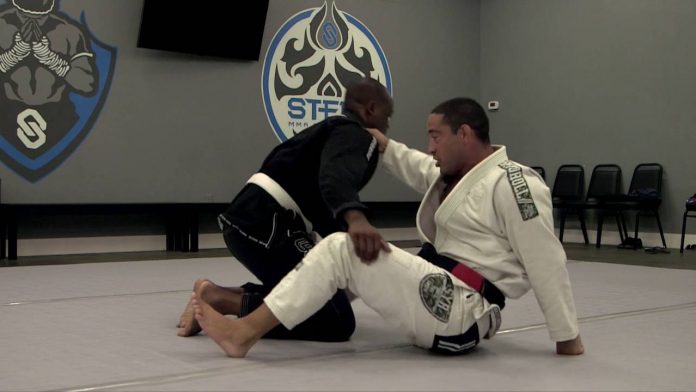
Playing guard in BJJ can be as simple or as complicated as you make it be. There’s a clear progression that we usually see here. At first, it is all about surviving so the closed and perhaps half guard are the options most people choose. As grapplers get to blue and purple belt, first they go into open guard variations and then straight into crazy land. After all the experimentation, once people get their brown belts they tend to look for simplistic ways to get what they want. Mind you, simply doesn’t necessarily mean boring, nor ineffective. On the contrary, there are certain guards that might seem like they do not even guard positions. Yet they work, especially at the highest levels of the game. One of those guards is the surprisingly simple collar guard. So, all you advanced purple belts and above, this one is meant for you.
Playing guard is fun! When if you’re not a fan of the guard, you still need to know how to deal with people when you’re n your back. With the collar guard, it’s mostly you on your butt, if we’re being honest. The original idea behind the closed guard was that of simplicity and control. While the closed guard offers both, it also requires quite a lot of work in order to set up attacks. namely, if you do not deal with the opponent’s posture and base, you’ll have a hard time doing anything. Open guards are usually more attacking in nature, but lack the control of the closed guard. Somewhere in between, is a simple guard that delivers on both. That said, do not expect closed guard-like control, nor spider guard-like attacks from the collar guard. Instead, expect safety, ease of movement and effortless sweeps.
To make things clear, the collar guard is far from the ultimate guard in BJJ. there’s no direct substitution for it without the Gi, making it useless in No-Gi. However, with the Gi it has an unusually wide range of applications. It can work as a guard, it can lead into takedowns from the top and it offers direct control from the top after a successful sweep. Furthermore, the guard’s mechanics offers a way to prevent your opponent from passing, while creating pain and discomfort literally without doing anything. And, most importantly, it is very easy to enter into either a closed or open guard variation from there or get back up to your feet in case you’re looking for a transition.
The Collar Guard
The collar guard is painfully simple to get, yet works like no other bottom position. The hardest part is getting the collar. For this guard, all you need is a cross collar grip on your opponent’s lapel. It is smooth sailing from there on.
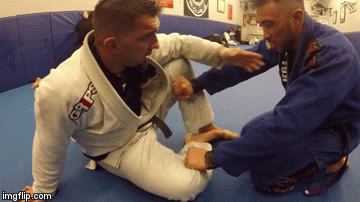
The arm you have gripping the opposite side collar should remain straight at all times. This is a crucial detail to make the guard work! You need a locked out elbow in order to have a strong frame. Furthermore, your knuckles should be right up against their collarbone, grinding up and down. This produces pain and discomfort, making the grip notoriously difficult to break. It also helps prevent any flying armbar/triangle attacks your opponent might be thinking of due to the extended arm. Speaking of the extended arm, as long as you keep your weight back and your spine straight you’ll have absolutely nothing to worry about.
Finally, your other arm should either post behind you in order to provide support for your frame, or you could look for additional control. there’s a variation called the collar and sleeve guard. The name pretty much explains it all. The free arm goes on their sleeve, taking away all their passing options as well as their posture. This variation is slightly better suited when playing the collar guard against a kneeling opponent.
Effective Collar Guard Attacks
Let’s start looking at some attacking options. Remember that his article is simply an overview of all your attacking options from the collar guard. In the future, we’ll focus more on some of them, analyzing them in-depth. For now, let’s just look at the options.
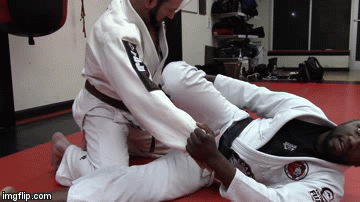
Hunting for leg locks is also fairly easy from there. Standing opponents caught in the collar guard have no posture, so moving them into certain directions is easy. Just like before, when a leg presents itself, getting to an Ahsi Garami is only limited by your knowledge of entries from different angles.
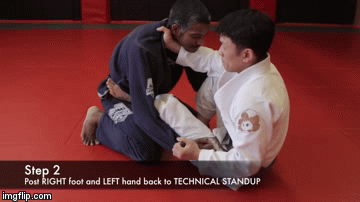
Transitions And The Collar Drag
The beautiful thing about the collar guard si that you can use it to transition if you do not like attacking directly. For example, having a collar and sleeve means arm drags are easy to get. Once you have an arm drag, you can easily get the back and finish from there. Once again, numerous leg lock positions are also right there. You can get there just by reacting to your opponent’s movements, without having to set anything up.
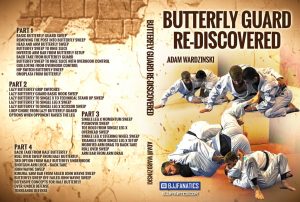
Adam Wardzinski is a Polish grappling phenom who has one of the nastiest guard games out there. His butterfly guard works because it is simple, effective and leads to his favorite submissions – leg locks. In his “Butterfly Guard Re-Discovered” DVD set, Adam shares all his knowledge of this powerful, yet easy to use, BJJ guard. Check it out and connect it to the collar guard for a killer guard game nobody can solve!
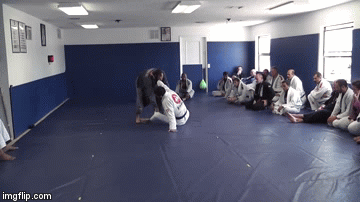


![Darce Choke Encyclopedia – Origins, Mechanics and Variations [2025] BJJ, choke, Brabo, BJJ Darce Choke, D'arce Choke, Darce BJJ Choke](https://bjj-world.com/wp-content/uploads/2017/11/JungPoirierLeeYahoo-218x150.jpg)









![X-Guard Trickery Kyle Sleeman DVD Review [2025] X-Guard Trickery Kyle Sleeman DVD Review](https://bjj-world.com/wp-content/uploads/2025/03/x-guard-trickery-kyle-sleeman-dvd-review-218x150.png)
![Countering with Crab Ride Anthony Budion DVD Review [2025] Countering with Crab Ride Anthony Budion DVD Review](https://bjj-world.com/wp-content/uploads/2025/03/countering-with-crab-ride-anthony-budion-dvd-review-218x150.png)
![Closet Closed Guard Craig Jones DVD Review [2025] Closet Closed Guard Craig Jones DVD Review](https://bjj-world.com/wp-content/uploads/2025/03/closet-closed-guard-craig-jones-dvd-review-218x150.png)
![Xanadu Back Takes Levi Jones-Leary DVD Review [2025] Xanadu Back Takes Levi Jones-Leary DVD Review](https://bjj-world.com/wp-content/uploads/2025/03/xanadu-back-takes-levi-jones-leary-dvd-review-218x150.png)

![No-Gi Grapplers Guide To Front Headlock Joel Bane DVD Review [2025] No-Gi Grapplers Guide To Front Headlock Joel Bane DVD Review](https://bjj-world.com/wp-content/uploads/2025/03/no-gi-front-headlock-joel-bane-dvd-review-218x150.png)
![Crossing and Spinning Steps To Attack Israel Hernandez DVD Review [2024] Crossing and Spinning Steps To Attack Israel Hernandez DVD Review](https://bjj-world.com/wp-content/uploads/2024/09/spinning-steps-to-attack-israel-hernandez-dvd-review-324x235.png)

![Creating Back Exposure Luke Griffith DVD Review [2025] Creating Back Exposure Luke Griffith DVD Review](https://bjj-world.com/wp-content/uploads/2025/01/creating-back-exposure-luke-griffith-dvd-review-100x70.png)
![Two Sides One Game Sweep and Pass Marcos Tinoco DVD Review [2024] Two Sides One Game Sweep and Pass Marcos Tinoco DVD Review](https://bjj-world.com/wp-content/uploads/2024/11/sweep-and-pass-marcos-tinoco-dvd-review-100x70.png)


![Guard Busters Bill Cooper BJJ DVD Review [2025] Guard Busters Bill Cooper BJJ DVD Review](https://bjj-world.com/wp-content/uploads/2025/03/guard-busters-bill-cooper-bjj-dvd-review-100x70.png)

![Eoghan O’Flanagan Bundle Down Right Sloppy Jiu-Jitsu Review [2024] Eoghan O'Flanagan Bundle Down Right Sloppy Jiu-Jitsu Review 2024](https://bjj-world.com/wp-content/uploads/2024/09/down-right-sloppy-jiu-jitsu-eoghan-oflanagan-bundle-100x70.png)

![Closed Guard Reintroduced Adam Wardzinski DVD Review [2025] Closed Guard Reintroduced Adam Wardzinski DVD Review](https://bjj-world.com/wp-content/uploads/2025/01/closed-guard-reintroduced-adam-wardzinski-dvd-review-100x70.png)


![Higher Tripod Passing Craig Jones DVD Review [2025] Higher Tripod Passing Craig Jones DVD Review](https://bjj-world.com/wp-content/uploads/2025/02/higher-tripod-passing-craig-jones-dvd-review-100x70.png)

![Assassin Choke Baret Yoshida DVD Review [2024] Assassin Choke Baret Yoshida DVD Review](https://bjj-world.com/wp-content/uploads/2024/10/assassin-choke-baret-yoshida-dvd-review-100x70.png)

![Systematically Attacking The Crucifix Gordon Ryan DVD Review [2024] Systematically Attacking The Crucifix Gordon Ryan DVD Review](https://bjj-world.com/wp-content/uploads/2024/10/systematically-attacking-the-crucifix-gordon-ryan-dvd-review-100x70.png)
![Top Half Guard Neil Melanson DVD Review [2025] Top Half Guard Neil Melanson DVD Review](https://bjj-world.com/wp-content/uploads/2025/02/top-half-guard-neil-melanson-dvd-review-100x70.png)
![Leg Locks From Beginner To Advanced Dan Manasoiu DVD Review [2024] Leg Locks From Beginner To Advanced Dan Manasoiu DVD Review](https://bjj-world.com/wp-content/uploads/2024/12/leg-locks-from-beginner-to-advanced-dan-manasoiu-dvd-review-100x70.png)
![No-Gi Defense Xande Ribeiro DVD Review [2024] No-Gi Defense Xande Ribeiro DVD Review](https://bjj-world.com/wp-content/uploads/2024/11/no-gi-defense-xande-ribeiro-dvd-review-100x70.png)

![Advanced Immortal Clinch Matt Brown DVD Review [2024] Advanced Immortal Clinch Matt Brown DVD Review](https://bjj-world.com/wp-content/uploads/2024/09/advanced-immortal-clinch-matt-brown-dvd-review-100x70.png)
![Double Sleeve Guard Jon Thomas BJJ DVD Review [2024] Double Sleeve Guard Jon Thomas BJJ DVD Review](https://bjj-world.com/wp-content/uploads/2024/10/double-sleeve-guard-jon-thomas-bjj-dvd-review-100x70.png)
![Underhooks With Uncle Jeff Glover DVD Review [2025] Underhooks With Uncle Jeff Glover DVD Review](https://bjj-world.com/wp-content/uploads/2025/02/underhooks-with-uncle-jeff-glover-dvd-review-100x70.png)

![Lockdown Quickstart Guide Cameron Mellott DVD Review [2025] Lockdown Quickstart Guide Cameron Mellott DVD Review](https://bjj-world.com/wp-content/uploads/2025/03/lockdown-quickstart-guide-cameron-mellott-dvd-review-100x70.png)


![Roger Gracie Guard Passing System DVD Review [2025] Roger Gracie Guard Passing System DVD Review](https://bjj-world.com/wp-content/uploads/2025/02/roger-gracie-guard-passing-system-dvd-review-100x70.png)